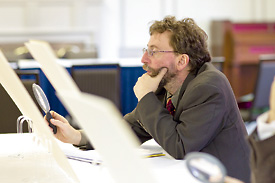Nearly 80 U-M faculty members enjoyed an unusual opportunity to engage with materials from U-M cultural collections Nov. 7 as they participated in this fall’s Provost’s Seminar on Teaching.
Provost Phil Hanlon urged faculty to tap their own senses of curiosity and imagination when planning their teaching, to expand their strategies, and to explore new ways to think about course material.

Matt Kaplan, managing director of the Center for Research on Learning and Teaching, uses a magnifying glass to read ancient texts during an interactive session of “Teaching with Collections: Engaging Students in the Archives, Museums and Gardens of the University of Michigan.” The session was part of the Provost’s Seminar on Teaching, which took place Nov. 7 at the Michigan League. Photo by Eric Bronson, U-M Photo Services.
He also gave an example from his own teaching, describing how he engaged students studying cryptology in a first-year class by having them decipher coded pages of an 18th-century letter by British General Thomas Gage.
“The experience moved students in ways that made-up problems do not. And the garbles (errors in coding) in the letter introduced a degree of real-world complexity that I would not usually have included in an introductory course. For the rest of the term and years later the students talked about ‘that General Gage Letter,’” Hanlon said.
The seminar program was developed by the Center for Research on Learning and Teaching (CRLT), in conjunction with the U-M Cultural Collections Council, a consortium of the university’s museums, archives, and the botanical gardens and arboretum. According to CRLT, more than 8,000 undergraduate students per year take classes that build on collaborations between faculty and curators.
Francis Blouin, director of the Bentley Historical Library and professor of history, represented the council when he discussed how richly students are rewarded when their professors teach using collections. Studying these materials, under the direction of faculty and curators, helps students cultivate achievement through developing independent analysis and exploring new materials for themselves.
Faculty participants had the unusual opportunity to be “novice learners” in six sessions led by curators from U-M collections, sharing observations and interpretations of materials with startling power in their singularity and in comparison.
After attending a session in which participants examined medieval manuscripts from the Special Collections Library, Frederick Amrine, Arthur F. Thurnau Professor of German, spoke about the power of confronting decontextualized objects.
“I realize that we stand on the shoulders of giants — editors, scholars, archivists — and forget how much labor goes into presenting primary texts,” he said.
Amy Harris, director of the Exhibit Museum, said that the session reminded her of the pleasure of close observation and how powerful that could be for students. Working with original objects gives students “the opportunity to slow down, look, and wonder, and piece things together,” something they don’t often have a chance to do, she said.
Mark Clague, associate professor of musicology and a faculty associate in American culture, agreed. “The human aspects in documents — the passion, the exclamation marks, the emotional language — are more apparent when working with original documents. They have a resonance for students who usually only see documents reproduced in textbooks or electronics scans,” he said.
In other sessions, faculty members perused historical photographs from the Clements Library, all taken on school “picture days.” Elsewhere, the participants handled and interpreted replicas of burial materials prepared by Kelsey Museum experts.
After the interactive sessions, the faculty members had the chance to think about how they could apply this kind of teaching to their own courses, and they heard panels of colleagues exchanging ideas they have used in teaching with collections.
The Provost’s Seminars, which are held twice a year, promote lively and substantive dialogues about a wide range of teaching and learning issues that are relevant campuswide.

